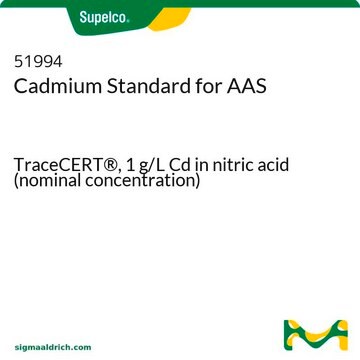270393
Tetrachlorethen
suitable for HPLC, ≥99.9%
Synonym(e):
Ethylentetrachlorid, PCE
About This Item
Empfohlene Produkte
Dampfdichte
5.83 (vs air)
Dampfdruck
13 mmHg ( 20 °C)
19 mmHg ( 25 °C)
Assay
≥99.9%
Form
liquid
Aufgereinigt durch
glass distillation
Methode(n)
HPLC: suitable
Verunreinigungen
<0.050% water
Abdampfrückstand
<0.0005%
Farbe
APHA: ≤10
Brechungsindex
n20/D 1.505 (lit.)
bp
121 °C (lit.)
mp (Schmelzpunkt)
−22 °C (lit.)
Dichte
1.623 g/mL at 25 °C (lit.)
λ
H2O reference
UV-Absorption
λ: 290 nm Amax: 1.00
λ: 295 nm Amax: 0.30
λ: 300 nm Amax: ≤0.20
λ: 305 nm Amax: 0.10
λ: 350 nm Amax: 0.05
λ: 400 nm Amax: 0.03
Anwendung(en)
food and beverages
SMILES String
Cl\C(Cl)=C(\Cl)Cl
InChI
1S/C2Cl4/c3-1(4)2(5)6
InChIKey
CYTYCFOTNPOANT-UHFFFAOYSA-N
Suchen Sie nach ähnlichen Produkten? Aufrufen Leitfaden zum Produktvergleich
Anwendung
- Dispersive liquid-liquid microextraction as a novel enrichment approach for compound-specific carbon isotope analysis of chlorinated phenols.: This study introduces a novel microextraction technique involving tetrachloroethylene, enhancing the sensitivity and specificity of carbon isotope analysis in complex environmental samples (Martin et al., 2024).
- Photo-on-Demand In Situ One-Pot Synthesis of Carbonate Esters from Tetrachloroethylene.: This research presents a novel photochemical method for synthesizing carbonate esters from tetrachloroethylene, demonstrating its potential in synthetic organic chemistry and industrial applications (Higashimura et al., 2024).
Signalwort
Warning
Gefahreneinstufungen
Aquatic Chronic 2 - Carc. 2 - Eye Irrit. 2 - Skin Irrit. 2 - Skin Sens. 1 - STOT SE 3
Zielorgane
Central nervous system
Lagerklassenschlüssel
6.1C - Combustible acute toxic Cat.3 / toxic compounds or compounds which causing chronic effects
WGK
WGK 3
Flammpunkt (°F)
No data available
Flammpunkt (°C)
No data available
Analysenzertifikate (COA)
Suchen Sie nach Analysenzertifikate (COA), indem Sie die Lot-/Chargennummer des Produkts eingeben. Lot- und Chargennummern sind auf dem Produktetikett hinter den Wörtern ‘Lot’ oder ‘Batch’ (Lot oder Charge) zu finden.
Besitzen Sie dieses Produkt bereits?
In der Dokumentenbibliothek finden Sie die Dokumentation zu den Produkten, die Sie kürzlich erworben haben.
Kunden haben sich ebenfalls angesehen
Unser Team von Wissenschaftlern verfügt über Erfahrung in allen Forschungsbereichen einschließlich Life Science, Materialwissenschaften, chemischer Synthese, Chromatographie, Analytik und vielen mehr..
Setzen Sie sich mit dem technischen Dienst in Verbindung.











